 Today we’re taking a look at 2 different D-Link home security cameras with full HD capabilities and 180 degree lenses to take in a crystal clear, wide angled view of the area that you set them up in. One of these cameras is meant specifically for indoor use, and the other is an outdoor camera. If you’re in the market for a new home security camera, read on for the full story on these 2 fine models.
Today we’re taking a look at 2 different D-Link home security cameras with full HD capabilities and 180 degree lenses to take in a crystal clear, wide angled view of the area that you set them up in. One of these cameras is meant specifically for indoor use, and the other is an outdoor camera. If you’re in the market for a new home security camera, read on for the full story on these 2 fine models.
D-Link Cameras Key Specs
 First up we’ll check out the D-Link WiFi Indoor 180-Degree HD IP Camera. This camera is extremely small and lightweight, but it certainly does a good job of protecting the interior of your home when you’re not available to do so yourself. It’s 180º wide eye lens in full HD 1080p resolution means that you can actually get the work of 2 cameras done with just this one unit. It shoots video at up to 30fps for a smooth delivery of everything its eye can see, and that eye can see quite a lot! Other useful features include motion detection with an instant e-mail notification system, night vision with 5m infrared LED lights that allow you to see almost as clearly in the dark as in daylight, a 4x digital zoom feature for when you need to get a better look at something fishy, and local video recording of up to 128GB of video footage via a micro SD card slot. The unfortunate part of this feature, however, is that the camera (both cameras, in fact) does not include an SD chip in the package. This seems like a significant failed opportunity as it would have been incredibly easy and rather inexpensive to simply include a micro SD card with each of these cameras. By the way, each of the features that I’ve mentioned to this point also apply to the D-Link outdoor camera. Lets move on and take a look at a few of that camera’s key features now.
First up we’ll check out the D-Link WiFi Indoor 180-Degree HD IP Camera. This camera is extremely small and lightweight, but it certainly does a good job of protecting the interior of your home when you’re not available to do so yourself. It’s 180º wide eye lens in full HD 1080p resolution means that you can actually get the work of 2 cameras done with just this one unit. It shoots video at up to 30fps for a smooth delivery of everything its eye can see, and that eye can see quite a lot! Other useful features include motion detection with an instant e-mail notification system, night vision with 5m infrared LED lights that allow you to see almost as clearly in the dark as in daylight, a 4x digital zoom feature for when you need to get a better look at something fishy, and local video recording of up to 128GB of video footage via a micro SD card slot. The unfortunate part of this feature, however, is that the camera (both cameras, in fact) does not include an SD chip in the package. This seems like a significant failed opportunity as it would have been incredibly easy and rather inexpensive to simply include a micro SD card with each of these cameras. By the way, each of the features that I’ve mentioned to this point also apply to the D-Link outdoor camera. Lets move on and take a look at a few of that camera’s key features now.
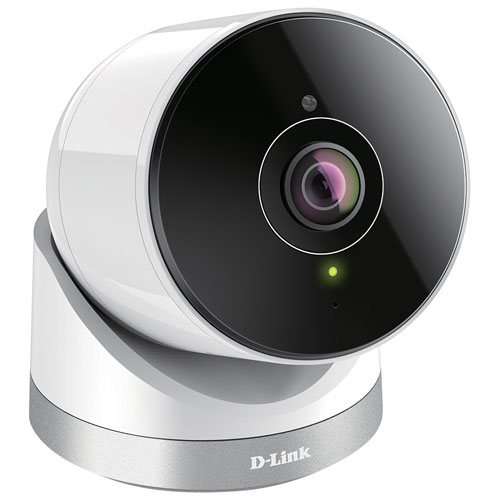 Ok, truth be told, the features I discuss next will mostly apply to the indoor camera as well. This camera, the D-Link Wi-Fi Outdoor 180 Degree 1080p IP Camera, does have one exception though, and that is its rugged, all-weather design (which can function in temperature conditions ranging from -25 degrees Celsius all the way up to 45 degrees Celsius on the hottest of summer days). Other features include high quality audio in the form of an integrated, omni-directional microphone, and full functionality (including remote viewing) via the mydlink Lite App. Just make sure that your smart device will meet D-Link’s minimum requirements before you pick one of these things up. By the way, the mic I mentioned above provides crisp, clear sound so you’ll easily be able to hear all that’s going on, and an audio detection feature lets you set your camera to record and will send you an email notification when something is picked up. Just be careful not to get your device & app too close to the cameras while they run or you may get a loud blast of audio feedback. While the high quality audio feature also applies to the indoor camera, one feature that doesn’t is the outdoor model’s ability to physically connect to your WI-FI router via an ethernet cord. Whether or not this is a benefit, though, will largely depend on your camera placement preferences. This is because the ethernet cord is rather short and limits where you can place the camera (unless you separately acquire a longer ethernet cord).
Ok, truth be told, the features I discuss next will mostly apply to the indoor camera as well. This camera, the D-Link Wi-Fi Outdoor 180 Degree 1080p IP Camera, does have one exception though, and that is its rugged, all-weather design (which can function in temperature conditions ranging from -25 degrees Celsius all the way up to 45 degrees Celsius on the hottest of summer days). Other features include high quality audio in the form of an integrated, omni-directional microphone, and full functionality (including remote viewing) via the mydlink Lite App. Just make sure that your smart device will meet D-Link’s minimum requirements before you pick one of these things up. By the way, the mic I mentioned above provides crisp, clear sound so you’ll easily be able to hear all that’s going on, and an audio detection feature lets you set your camera to record and will send you an email notification when something is picked up. Just be careful not to get your device & app too close to the cameras while they run or you may get a loud blast of audio feedback. While the high quality audio feature also applies to the indoor camera, one feature that doesn’t is the outdoor model’s ability to physically connect to your WI-FI router via an ethernet cord. Whether or not this is a benefit, though, will largely depend on your camera placement preferences. This is because the ethernet cord is rather short and limits where you can place the camera (unless you separately acquire a longer ethernet cord).
Testing and Use

Testing the D-Link cameras wasn’t as smooth a process as I had hoped and expected, but it was very rewarding in the end. Downloading the mydlink Lite App was as easy as scanning a QR code, and setting up an account was equally straightforward. The trouble began when I attempted to install the first (indoor) camera. For whatever reason, I just couldn’t establish a connection with the camera’s own WI-FI network. I then tried the second (outdoor) camera, and that one worked perfectly right away. This was a bit confusing, so I jumped on the line with D-Link’s customer support team for Canada and had the indoor camera up and running within about 5 minutes. I’m still not quite sure what the problem was, but the customer support staff was certainly very helpful and it was mostly smooth sailing from that point on.
One issue that I did notice with both cameras, though, was a bit of a lag between what was happening in front of them and what I was seeing in the app, and at some points the recording just seemed to skip ahead by a few seconds at a time. I do believe that this was most likely due to my own internet connection though, so I’m not holding it against the cameras. In fact, the footage captured by both cameras was crystal clear and every bit as wide angled as expected, so I was quite impressed with it overall. See below for a screen capture that I got of myself walking around outside my home.
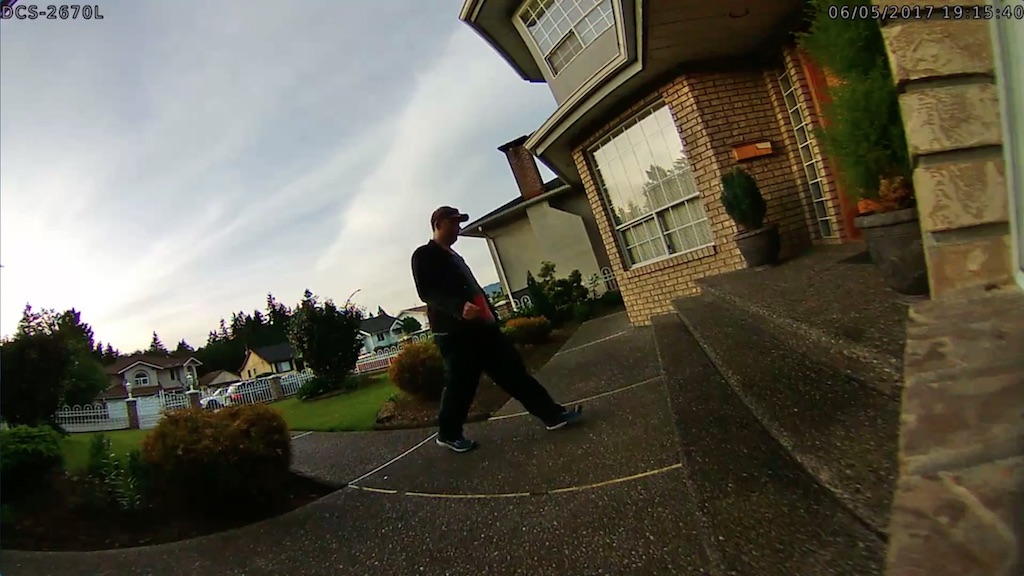
Equally impressive was the D-Link cameras’ night vision footage. When the infrared lights come on, which you can easily control via the app, everything instantly becomes incredibly clear. The lag did seem a bit worse at night, but I certainly couldn’t fault the image quality. See the image below for an example of how it looked. Also note that you can easily select among multiple resolution levels within the app, which may help to greatly decrease any lag that you experience between the camera and your smart device in many cases.
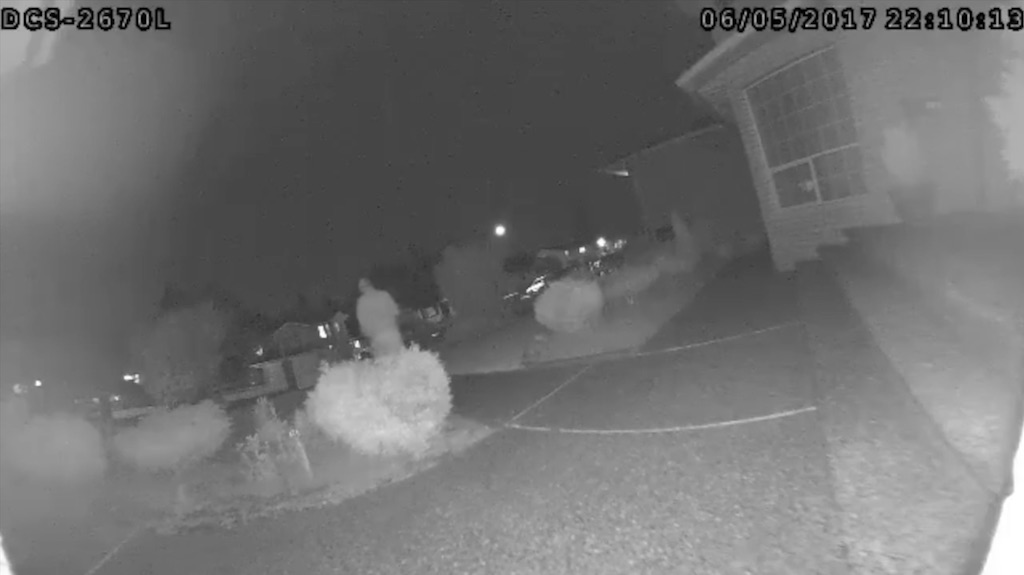
Overall I would have to say that I was extremely impressed with the D-Link 180 degree cameras. They may not have been perfect, but they did lend a feeling of tighter security to my home while I tested them, and they also outperformed every other home security camera that I’ve tested in the past.
Examining the Video Evidence
Please take a couple of minutes to check out my brief video overview of the 2 cameras discussed above. In it I give a close up look at each of the cameras and show some of the footage that they collected (both daytime and nighttime footage):
Final Thoughts
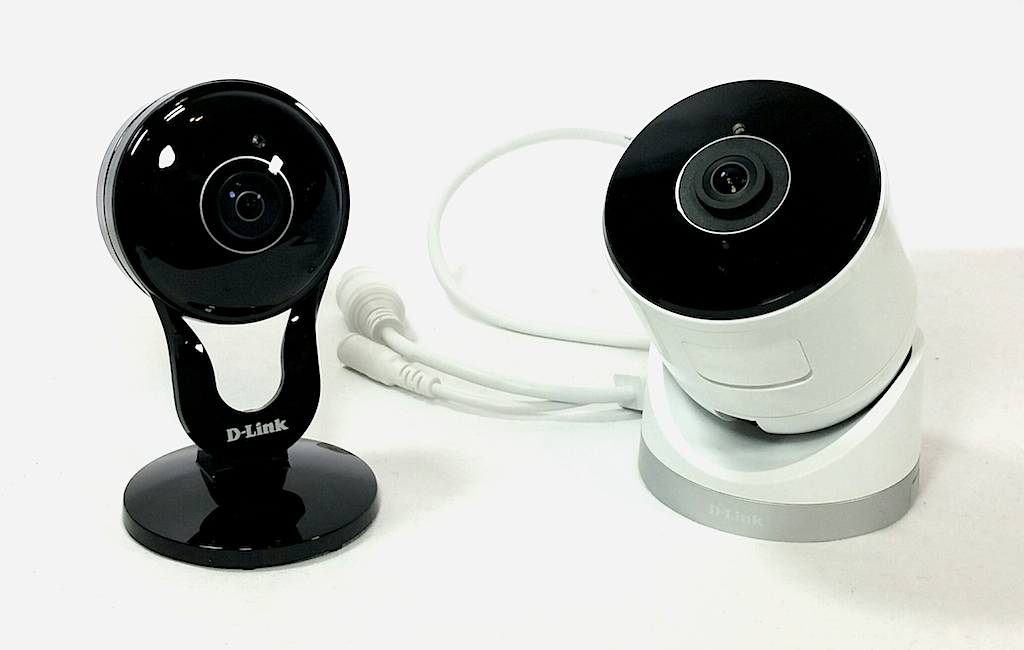 Each of these cameras impressed me in its own way. I definitely found the outdoor model to be the more physically robust unit, and the indoor one is small and discreet enough to truly be unobtrusive anywhere. Equally, both cameras ultimately did exactly what they were meant to do and were very easy to use once the initial setup was complete. I especially enjoyed using the mydlink Lite app, which allows you to keep both cameras linked (as many as 99 cameras at once in fact) and you can switch back and forth between them as much as you like. Overall, the experience of using these D-Link cameras was quite a good one. A little snag in the beginning with the indoor one was quickly overcome, and after that the cameras performed relatively well and provided me with solid home security. If you’re currently on the hunt for new security cameras for your home, these 2 D-Link 180 degree models may just fit the bill!
Each of these cameras impressed me in its own way. I definitely found the outdoor model to be the more physically robust unit, and the indoor one is small and discreet enough to truly be unobtrusive anywhere. Equally, both cameras ultimately did exactly what they were meant to do and were very easy to use once the initial setup was complete. I especially enjoyed using the mydlink Lite app, which allows you to keep both cameras linked (as many as 99 cameras at once in fact) and you can switch back and forth between them as much as you like. Overall, the experience of using these D-Link cameras was quite a good one. A little snag in the beginning with the indoor one was quickly overcome, and after that the cameras performed relatively well and provided me with solid home security. If you’re currently on the hunt for new security cameras for your home, these 2 D-Link 180 degree models may just fit the bill!


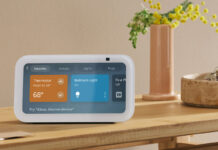
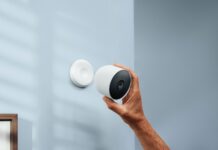
Wish this camera could do POE – Power Over Ethernet. Wonder can they do a firm ware up for this. I thought this camera did this based on a youtube video. I’ll prob have to return this for something POE. Am all roughed in from my basement to my attic with an ethernet line and a POE splitter.
The Ethernet cable is short because it is only used to configure the camera … not to use it like that. People with non-WPS routers need to do this. This is a wireless camera.
These cameras should never come with SD cards. First, you will pay more for the camera. Second, they will not provide the size you want anyway. Third, people who record all.of their cameras to hard disk using the D-Link DNR-202L, like me, don’t want to pay for an SD card that we will never use. It is a waste of money.
I like to place it out door under my front door overhang where it could view three different entry ways into the house
I would place this camera outdoors showing the driveway. Cars on our street have had tires slashed and broken into.
Comments are closed.